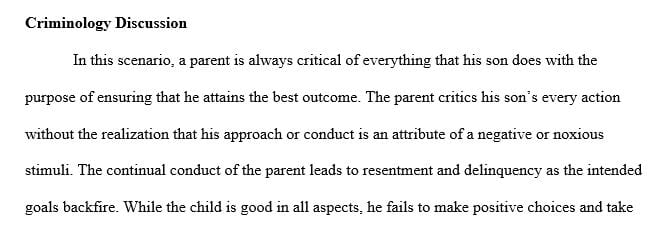What is the purpose of the cognitive restructuring theory
Criminology Discussion
A general strain theory was proposed by Robert Agnew. In this theory, he proposed that strain did not arise when people had a failure to meet the American Dream, but that everyone, in every social class, had frustrations in his or her daily life.
Most strain theorists listed failure to achieve goals as a major strain precipitator. Agnew had identified two additional sources of strain: presentation of noxious stimuli and removal of positively valued stimuli. Examples of presentation of noxious stimuli would be an abusive parent, an overly critical instructor, and an overly demanding employer. Examples of the removal of positively valued stimuli would be losing a job, getting a divorce, and filing for bankruptcy.
Primary Task Response: Within the Discussion Board area, write 400–600 words that respond to the following questions with your thoughts, ideas, and comments. This will be the foundation for future discussions by your classmates. Be substantive and clear, and use examples to reinforce your ideas.
Create a scenario that would fall under the strain theory.
In the scenario, provide an explanation of each of the following:
The loss of the major goal
The presentation of the noxious stimuli
The removal of the positively valued stimuli
When you have these 3 inputs of strain in your scenario, address the following:
How would the person in the scenario react with criminal behavior or behavior that would not be acceptable to society? Explain.
How could cognitive restructuring be used to prevent the person from partaking in criminal behavior? Explain
Criminology Individual Project
Tom is driving his brand-new sports car to work. He is very proud of his car because it took a long time to save for his down payment. While stopped at a four-way intersection, he was waiting to proceed into the intersection when another vehicle cut him off.
This made him slam on his breaks, and he waited for the other person to go through the intersection. This behavior set off his anger, and he became irate and started yelling at the other driver. This was an automatic reaction on his part. The cognitive restructuring theory could teach him how to handle his excessive anger.
Assignment Guidelines
Using the library, course materials, textbook, and Web resources, research the 4 steps in cognitive restructuring.
Address the following in 2-3 pages:
What is the purpose of the cognitive restructuring theory? Explain.
How would the cognitive restructuring theory help Tom from the scenario above in handling his excessive anger? Explain.
What are the steps that he should take to control his anger? Explain and be specific.
Describe a situation that you were in where the cognitive restructuring theory could help.
Explain the situation using the 4 steps in cognitive restructuring.
If left unchecked, how could frequent outbursts of excessive anger eventually result in serious criminal or socially unacceptable behavior? Explain.
Use at least 3 scholarly sources to fully support your arguments.
Be sure to reference all sources using APA style
Juvenile Delinquency Discussion
Primary Task Response: Within the Discussion Board area, write 400–600 words that respond to the following questions with your thoughts, ideas, and comments. This will be the foundation for future discussions by your classmates. Be substantive and clear, and use examples to reinforce your ideas:
Do you feel that juvenile delinquency can effectively be curbed by the threat of corporal punishment? Why or why not?
Do you feel that juvenile delinquency issues should be addressed by the threat of corporal punishment? Why or why not?
How would this punishment interact with the laws now with regard to child abuse? Explain.
Do you think corporal punishment would have a lasting adverse effect on the psyche of the child? Why or why not?
Juvenile Delinquency Individual Project
A split sentence is one in which a juvenile is waived to adult court and then given a juvenile sanction and an adult sanction. If the offender fails the juvenile sanction, he or she will automatically be given the adult punishment.
Using the library, course materials, textbook, and Web resources, research the advantages and disadvantages of split sentences and any other pertinent issues with regard to split sentencing.
Address the following in 600–900 words:
What is split sentencing? Describe in detail.
Provide and describe 1–2 examples of split sentencing successes.
Provide and describe 1–2 examples of split sentencing failures.
Based on your research, is split sentencing an effective solution to a juvenile problem? Why or why not?
Many opponents feel that juvenile offenders issued a split sentence are simply getting off easy. Do you agree with this sentiment? Why or why not?
Answer preview to what is the purpose of the cognitive restructuring theory
APA
3141 words


